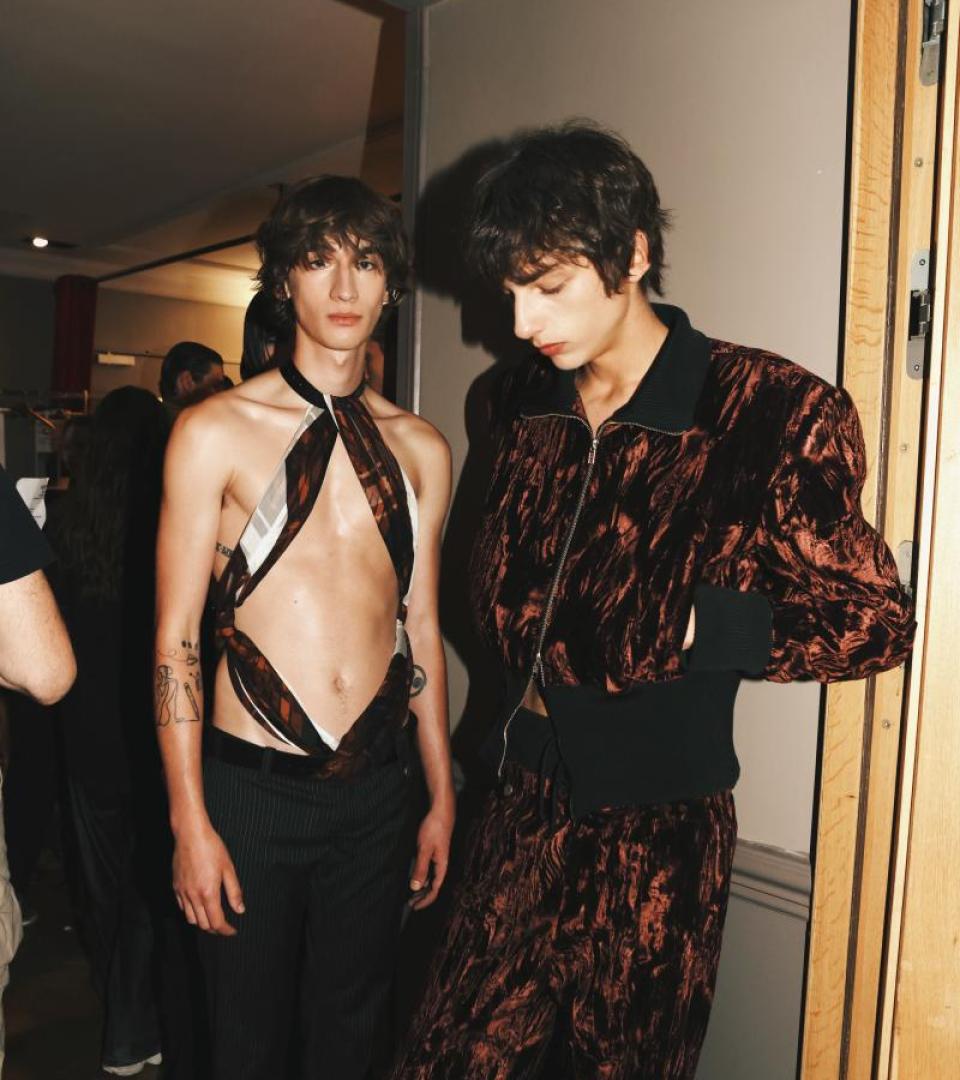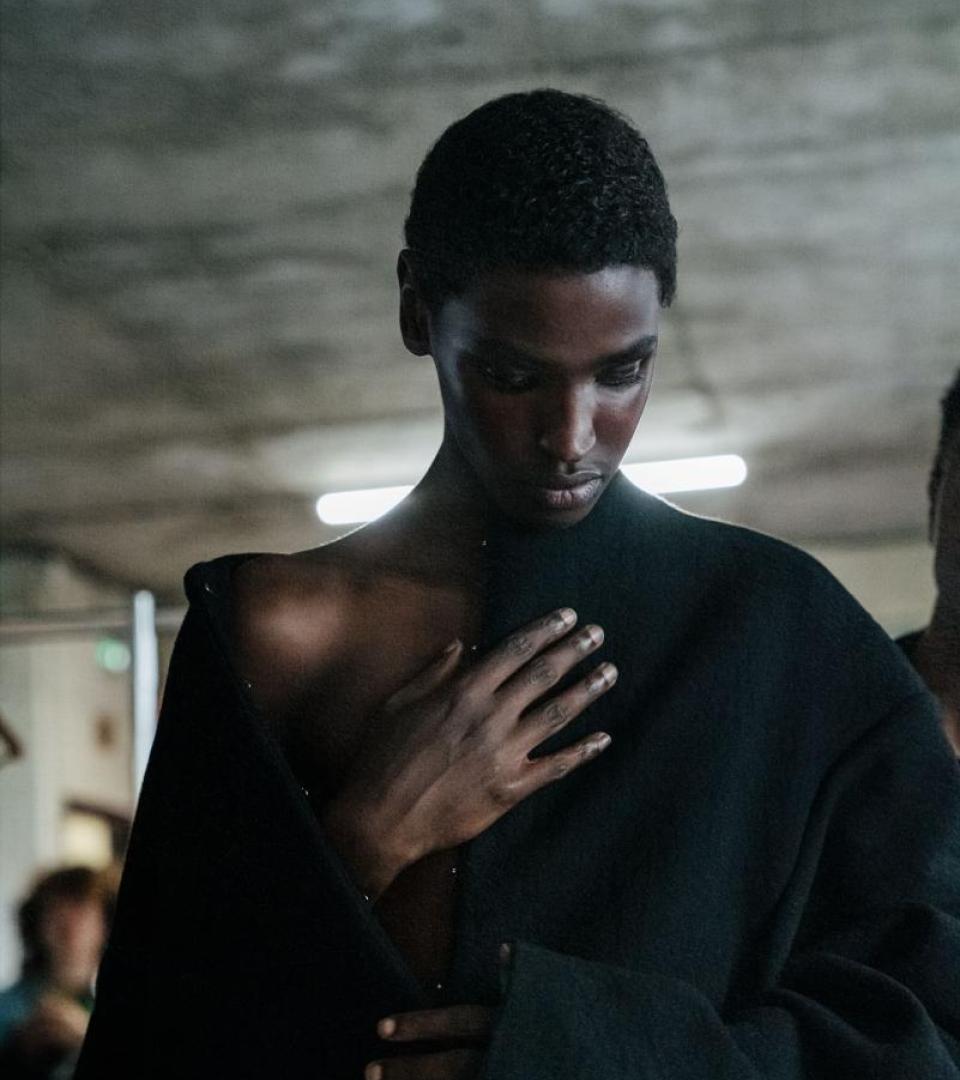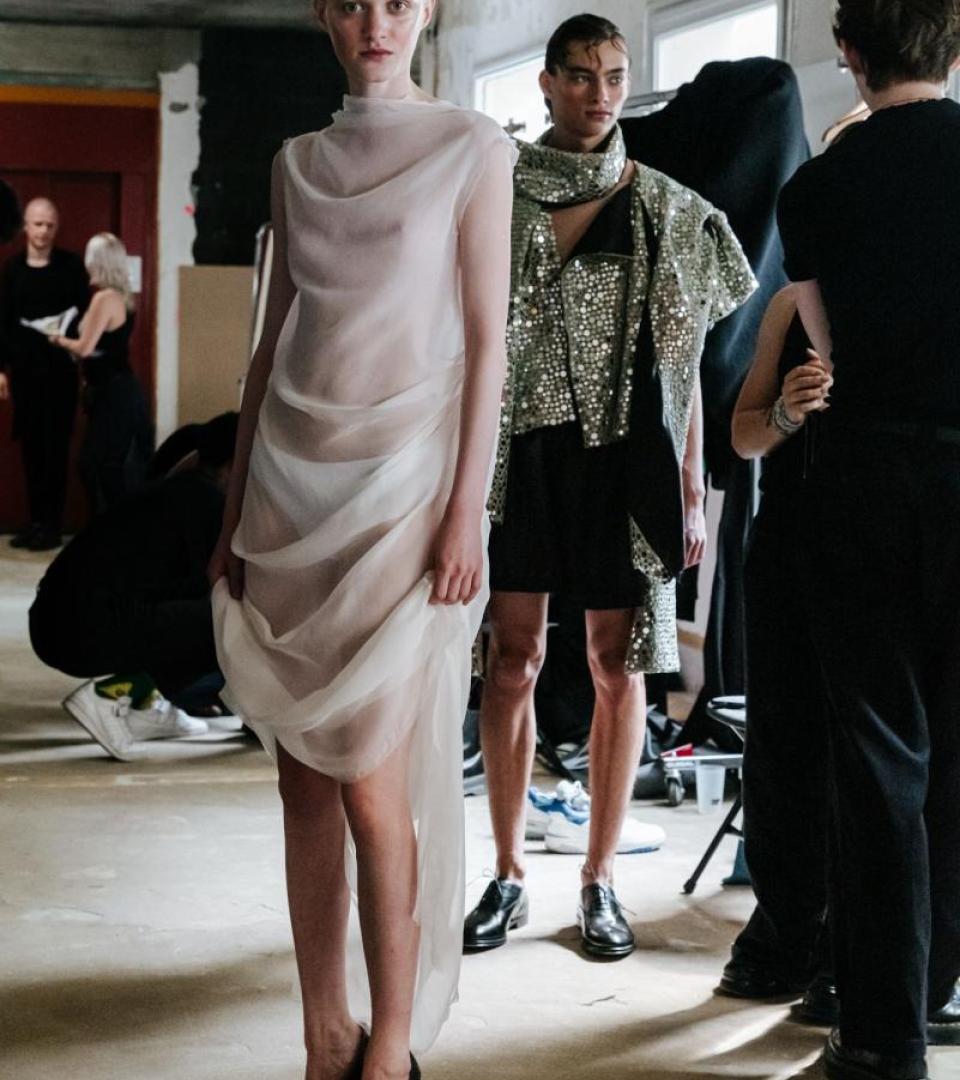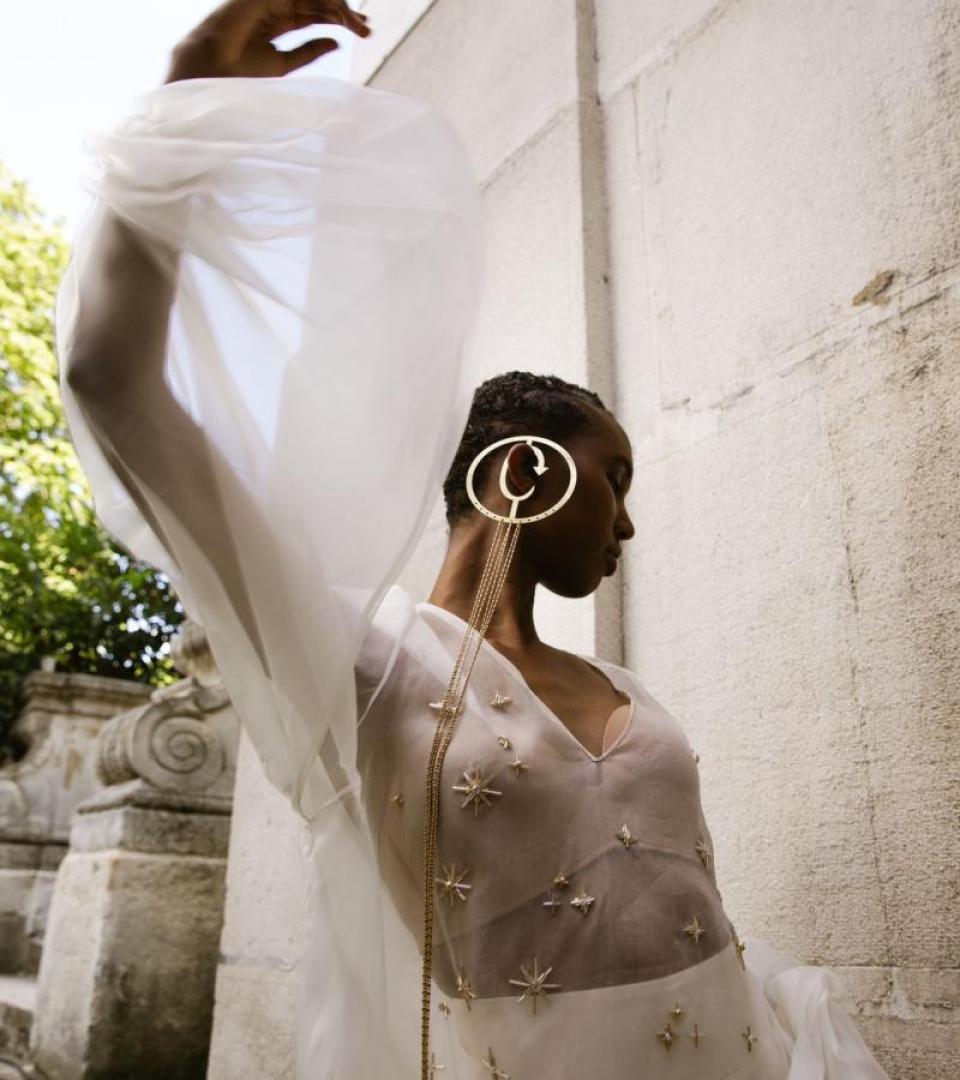Frédéric Sanchez: “I like to create sounds that make you think, that provoke something extreme.”
Sound illustrator Frédéric Sanchez has carved out of fashion his own field of expression. Beginning with Martin Margiela, he has built enduring relationships with numerous Houses – including Hermès, Jil Sander, Duran Lantink, Prada and Miu Miu, to name just a few – crafting original compositions for shows conceived as total performances. He also continues his own artistic exploration, driven from the very beginning by “an urgency to do.”
Dozens of cables cover his desk and vinyl records on the shelves sit alongside books on art, fashion and, of course, music. It is in his Paris studio that Sanchez recounts his career with calm, smiles and poetry. A poetry that probably explains the collaborations he has built with fashion designers, some lasting several decades. Because they share a common sensibility, each with their own favoured medium: textiles for them, sound for him. “I quickly realised that what I do has nothing to do with making music or DJing. It's something else; I stick images together. And when one day I was asked what my job was, the name sound illustrator came to me.” It was a role he built for himself, led by an instinctive, then visceral passion for sound and music. Fashion came later. Against the backdrop of his Parisian childhood, Spanish radio played in the family living room. “It stayed with me, the idea of being in Paris with a sound from elsewhere, and of being, thanks to sound, in several different places.” When his sister brought home a Beatles vinyl record, he was immediately fascinated. “I didn't understand English and I imagined Abbey Road as an incredible woman, the kind of thing you might tell yourself when you’re seven years old. I had a kind of revelation.” He started to immerse himself in his first references: “I was fascinated by the album covers of Roxy Music, King Crimson and the band Wire. I found them extremely sophisticated and they inspired me a lot. And that led me to opera and contemporary music. My playground was the FNAC Montparnasse in Paris, [a store for CDs, books, and electronics]. All my pocket money went there.”
“I quickly realised that I had to stop studying. I felt an urgent need to do things, and fast.”
Sanchez grew up in a culturally vibrant context where artistic disciplines intermingled. “Dance, music, video – it all nourished me enormously. And fashion worked with that.” In the early 1980s, when Jack Lang was French Minister of Culture, dance was placed at the centre of the country’s cultural policy. Among the emerging companies, he discovered Régine Chopinot’s, who collaborated with Jean Paul Gaultier on costumes. “And in England, Michael Clarke was working with the BodyMap fashion label, ” he recalls. Advised by a close friend, he turned his attention to a career in public relations and began contacting everyone in Paris. He started out at the Théâtre du Châtelet before joining the press office of Béatrice Keller, who notably worked with Nina Ricci, and then that of Michèle Montagne, a central figure in Parisian fashion at the time. Under her wing, he attended his first fashion show on 19 October 1985: Jean Paul Gaultier's first menswear show, entitled “Et Dieu créa l'Homme” (And God Created Man). “The music was incredible. I remember very well the singer Sapho with the bassist Mick Karn from a band called Japan. That's what I was listening to at the time, I recognised them immediately.” Thanks to Montagne, he also met the designer Martine Sitbon and her collaborator, the stylist Marc Ascoli. Sitbon had just launched her fashion House in 1986, before being appointed creative director at Chloé in 1988. “One day, she called because she had a problem with the music for her fashion show. Michèle suggested that I go and see her, explaining that I knew a lot about it.” Sanchez was shown the collection and the inspirations, and the references came to him spontaneously: “Love and the Rockets, Hermine Demoriane, classical music. They loved it.” This decisive first experience laid the foundations for his future career.
Sanchez quickly left the world of press offices to help a friend set up the Java modelling agency. “That's where I understood the importance of image-related professions in fashion.” It was through Agathe Bertrand, the agency's leading model, that he was introduced to Martin Margiela, then first assistant to Jean Paul Gaultier. “He was about to launch his House when Agathe called me. She said we could do something together.” From the moment they met, he felt a strong connection: “There was a creative language that I understood: Andy Warhol, the Velvet Underground, the memory of clothes, the aesthetics of destruction. It was very exciting. It spoke to me.” Margiela, a pioneer of upcycling, and Sanchez, a sound collages devotee, shared the same approach: assembling, transforming and reinventing existing fragments to create something new. “I bought a tape recorder and immediately used this method to create my story.” Margiela's first fashion show took place at the Café de la Gare in Paris on 23 October 1988. For the two young creatives, it was the dawn of remarkable journeys.
“What interests me is collaboration, dialogue with designers. I have built up a lot of long-term relationships.”
“When I work for Dior, it's with Jonathan Anderson. I like to talk directly with designers to get an overall vision of the show.” Each encounter becomes an opportunity for dialogue that stretches on, sometimes for decades. From the outset, he worked with Jil Sander thanks to Marc Ascoli, and with Balmain with the then artistic director for menswear, “the formidable Bernard Sanz”. He also teamed up with Jean-Charles de Castelbajac for three seasons. “He contacted me and the music work spilled over into other areas, such as casting, sets and lighting.” These early experiences allowed him to define his own method: understanding each designer's universe and constructing a unique narrative for each collection. “I always ask where the speakers are located in the room, I like enveloping sound,” he explains. He followed Margiela when he joined Hermès in 1997, continued with Gaultier, who took the reins of the fashion House's women's collections from 2003 to 2010, and now collaborates with Nadège Vanhee-Cybulski, who has been in post since 2014.
In 1994, his curiosity propelled him to New York, always seeking fresh creative voices. “I was determined to work for Calvin Klein; it was my obsession. His slightly subversive, very minimalist, very American universe reminded me of Robert Mapplethorpe, Philip Glass, Steve Reich...” Sanchez's pantheon comes to him spontaneously when he talks, a catalogue of talents and artworks that one could almost imagine gravitating around him. Shortly after landing in the city, he met Marc Jacobs and Anna Sui and worked with them from his first season in New York. He began collaborating with Calvin Klein the following season and even found himself composing the music for the first Miu Miu fashion show in New York in 1995. Sanchez realised how closely intertwined the worlds of fashion and music are: “Marc Jacobs is close to Kim Gordon of Sonic Youth, and for years I saw the entire musical avant-garde in the front rows of Anna Sui's fashion shows. I worked for each of them for over twenty years. And always with my tape recorder, making my collages!”
“I like to do things that make people think, that create emotions. I seek to provoke something extreme.”
“At Prada, there were a few times when people walked out of the show. I'm not necessarily talking about the music, but the overall experience. It's a bit awkward to only talk about the music. It's the whole package that makes it interesting and meaningful.” The big fashion names and the emerging designers: Sanchez might work with Comme des Garçons in the morning and marvel at the work of a still unknown talent in the afternoon. “I saw Craig Green’s second collection and loved it, so I got in touch with him. We've been working together for seven years now.” These are encounters based on love at first sight and a time-consuming work process. “I like to spend time on each project, to start early on to develop my thinking. It must never become too mechanical.”
Beyond fashion shows, brands also entrust him with designing the soundscapes for their boutiques. “We do this for Ferrari, for Givenchy... For Miu Miu, for example, we draw up playlists that last 12 hours. It’s very complex work. The playlist can’t be the same in Paris as it is in the Middle East.” For the past ten years, he has also been developing musical composition, creating complete soundscapes from scratch for certain brands such as Ferrari, Wooyoungmi and Toteme.
“My work with fashion was completely ephemeral. It appeared and then disappeared. And at one point, it started to weigh on me a little. When the internet arrived, I saw all my work come back to me, like a boomerang, and I hated it. I found it strange.”
Crafting bespoke soundtracks for each collection – “it's almost Haute Couture!” – then carrying on: revisiting past work can be unpleasant when you only create in the present moment. “I was strongly encouraged to develop my personal work, and it came at a time when I needed to do other things on the side, things that weren't commissions but more independent work.” Like any artist, he constantly explores the possibilities of his favourite medium. “It's like I'm painting, except I'm doing it with sound.” When the Louvre opened its doors to contemporary art for the first time with the 'Contrepoint' exhibition in 2004, thanks to “the wonderful curator Marie-Laure Bernadac”, he presented “La Salamandre”, a sound installation. “It was a work about rumour and religion. I thought a lot about the idea of the movement of sound and how it works with people in motion.” He even developed collaborations, alongside fashion designers, with visual artists such as Louise Bourgeois. “I also worked a lot with Bettina Rheims, notably on a project about gender identity. She had photographed transgender people and there were these shifting voices. As soon as she photographed someone, I would create a sound installation that worked with the photos.”
Unstoppable, he even ventured into cinema and supervised the music for three films: “Le Secret” directed by Virginie Wagon, “Intimité” directed by Patrice Chéreau (winner of the Golden Lion at the Berlin Film Festival) and “La Femme de l'anarchiste” directed by Peter Sehr and Marie Noëlle. However, fashion remained his territory. “In cinema, I hadn't found the right person, as I had with Margela Margiela, with whom I could start a collaboration.” Here, the methods, timings and exchanges are not the same. “In my experience, there wasn't the laboratory aspect, and that's also what interests me. Fashion, when you're in the midst of preparing a show, is absolutely boiling. I always keep that urgency, my urgency to do things, very quickly.”
Reuben Attia



